Arg-e Alishah in Tabriz: A 700-Year-Old Citadel
Among Tabriz's many attractions, the 700 years old Arg-e Alishah stands out as a monumental piece of the city's past.
Constructed in the 14th century during the Ilkhanate era, Arg-e Alishah—also known as Arg Alishah or the Citadel of Alishah is the remnants of a large acropolis fortification and city wall in downtown Tabriz.
It was originally a compound boasting a massive vaulted mosque, extensive prayer halls, libraries, a vast courtyard with a reflecting pool, and a mausoleum, all encircled by a defensive wall. Its vaulted ayvan was renowned for being larger than the historic Taq Kisra in Ctesiphon.
Despite its grandeur, the structure faced setbacks, including destruction by natural disasters like earthquakes or by humans like wars. In the 19th century, the Arg transformed into a strategic fort during rising tensions between Iran and Russia, incorporating military barracks and a cannon foundry.
Today, Arg-e Alishah in Tabriz still stands as one of the tallest and oldest historical walls in Iran visible from far distances in Tabriz. Stay with us to learn everything you need to know about this iconic landmark in Tabriz and discover what makes this historical site a must-visit.
Why Visit Arg-e Alishah in Tabriz
- Arg-e Alishah is a crucial historical site in Tabriz, having witnessed various turbulent periods and serving as a stronghold for freedom fighters throughout its history.
- Visitors can see the marks of cannonballs on the citadel’s walls, which offer a poignant glimpse into the city's painful history and its resilience.
- The grandeur and height of Arg-e Alishah reveal the exceptional skill and ingenuity of its medieval architects, who achieved such feats without modern tools.
History of Arg-e Alishah in Tabriz
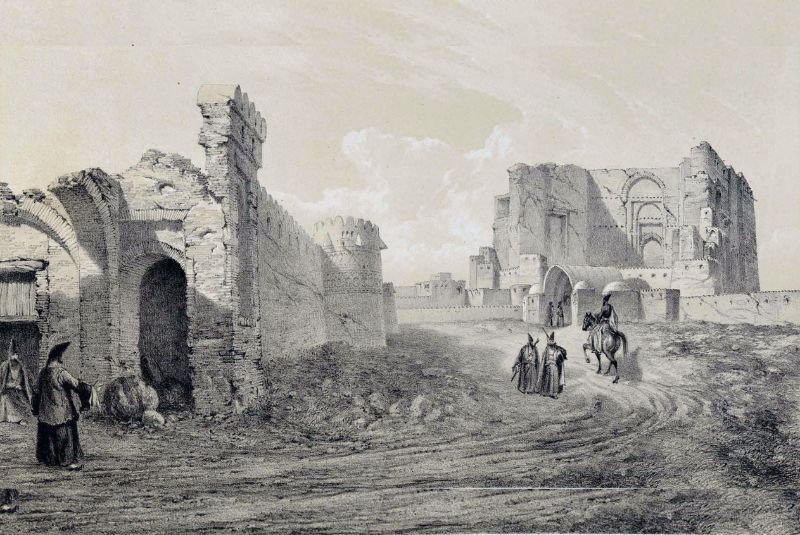
Early Construction
The Arge Tabriz was constructed between 1318 and 1339 CE under the directives of Taj al-Din Alishah Gilani, a minister during the Ilkhanid Mongol era. The initial goal was to build a grand mausoleum within the mosque’s courtyard, replacing an earlier mosque on the site.
Historical accounts describe an ambitious plan where Alishah aimed for the arch of the mosque to exceed the height of the Arch of Ctesiphon by about 416 meters. However, due to rushed construction and unstable foundations, the arch collapsed.
With Alishah’s death, the project was left unfinished. The unfinished structure faced further devastation in 1641 CE when a powerful earthquake severely damaged and collapsed much of the remaining structure.
Qajar Era
By the Qajar period, Arg-e Alishah had transformed into a significant military fortification and storage facility. During the Russo-Iranian Wars (1804–1828 CE) and the Anglo-Iranian War (1857 CE), the citadel was repurposed as a military base.
Crown Prince Abbas Mirza oversaw the addition of critical military infrastructure, including barracks and a foundry. The Qajar period also saw the construction of the Kolah Farangi building within the citadel’s grounds.
Constitutional Revolution
During the Constitutional Revolution, Arg-e Alishah played a crucial role as a stronghold for constitutionalists. The citadel was instrumental in the defense efforts led by figures like Sattar Khan and Bagher Khan against the forces of Mohammad Ali Shah Qajar. The walls of the citadel still bear the marks of cannonball impacts from this turbulent period.
Post-Constitutional Era
Following the Constitutional Revolution, Arge Tabriz continued to be a strategic military base. In 1911, during the Russian occupation, the citadel faced further damage as Russian forces bombarded it. The site saw additional modern constructions, including the Najaat School and an amphitheater, reflecting its evolving use and significance.
Pahlavi Era
In 1931, the Qajar-era fortifications were dismantled to create a public park. This demolition continued from 1971 to 1978, with many structures from the Qajar period removed to make way for green spaces. During the Pahlavi era, the area was transformed into a national garden. After the Islamic Revolution, its use shifted to serve as a prayer space.
Islamic Republic Era
In 1981, only three years after the Islamic Revolution, significant parts of the citadel, including the northern wall and Qajar-era staircase, were demolished to make way for a new prayer hall.
Excavations in 1997 and from 2000 to 2012 caused further damage, erasing much of the Qajar-era remnants. A new mosque was constructed adjacent to the Arg-e Alishah.
The Architecture of Arg-e Alishah in Tabriz
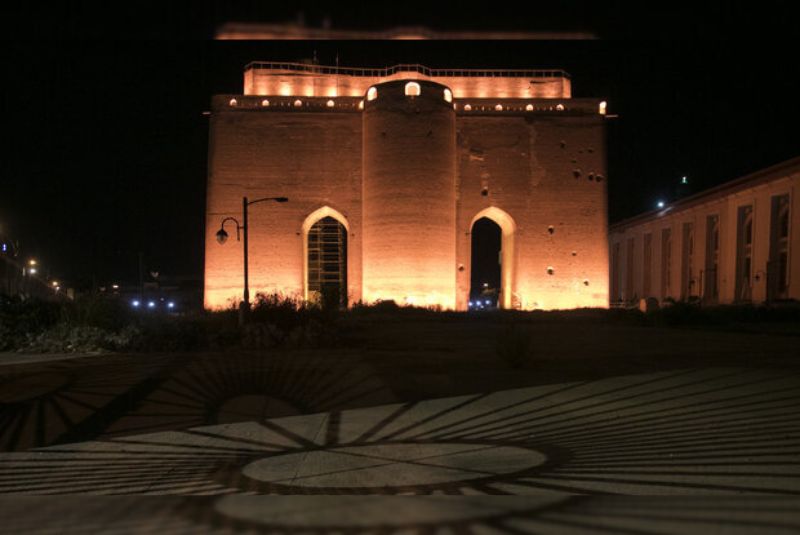
Arg-e Alishah, a monumental structure in Tabriz, stands as a testament to the grandeur of Iranian architectural artistry. Constructed between 1318 and 1339, this fortress was commissioned by Taj al-Din Ali Shah Gilani during the Ilkhanate era. Its architectural design represents a critical example of the Azeri style, an architectural approach prevalent in Iran during the Mongol Ilkhanate rule.
The Azeri style, also known as the Iranian-Mongol or Mongol style, flourished between 654 and 736 AH (1256 and 1336 CE). This style is characterized by its distinctive blend of Mongol and Persian elements, reflecting the cultural synthesis of the time. The Arg-e Alishah was constructed using traditional materials like sarooj (a type of mortar) and other durable materials, which were common in the period.
The original structure of Arg-e Alishah was a grandiose edifice, featuring three towering walls arranged in a way that they formed an immense arcade. Each wall reached a height of 26 meters and a width of 30 meters, with the walls themselves being approximately 10 meters thick.
The interior of these walls housed two broad inner walls, connected by arches that supported the expansive vaulted ceilings. Excavations reveal that about 7 meters of these walls were buried underground, a testament to the depth and scale of the original construction.
Unfortunately, the grandeur of Arg-e Alishah was not without its vulnerabilities. The building suffered significantly from earthquakes, particularly one in the 10th century, which caused substantial collapse and damage. Despite these setbacks, the surviving parts of the fortress's walls still bear witness to its historical majesty.
In its heyday, as described by prominent historians such as Ibn Battuta and Hamdollah Mostofi, the Arg-e Alishah was adorned with beautiful tile work, marble columns, stone wainscoting, intricate stucco decorations, and elegant inscriptions. These features highlighted the building's status as a significant religious and civic center during Taj al-Din Ali Shah's time.
Over the centuries, the Arg-e Alishah faced further destruction due to various conflicts, including the wars between Iran and Russia and Iran and Britain. In the Pahlavi era, many of the Qajar-era additions were demolished in an attempt to restore the original Ilkhanate architecture.
However, this process resulted in the loss of much of the structure's historical layers, leaving only a small section of the back wall, which still bears visible bullet and cannonball marks.
Today, the remaining structure of Arg-e Alishah is used for Friday prayers, with a large mosque constructed next to it, overshadowing the historical site. Despite the challenges faced, Arg-e Alishah remains a remarkable symbol of Iran's architectural heritage and was registered as a national heritage site on December 15, 1931.
Best Time to Visit Arg-e Alishah in Tabriz
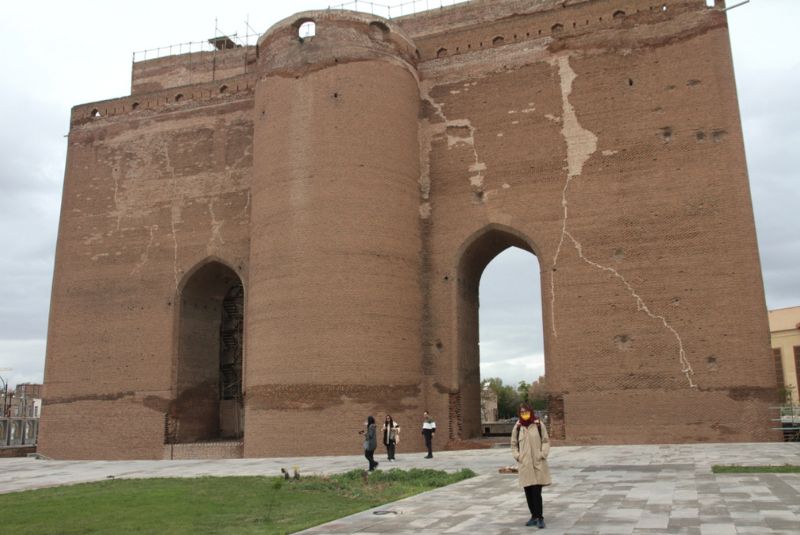
Arg-e Alishah, located in Tabriz, is best visited during spring and summer. The city experiences cold and windy autumns and winters, and the open space of the citadel allows the wind to circulate, making it feel even chillier.
For visitors who are not fond of cold weather, spring and summer provide a more comfortable experience. In particular, May is an ideal time for those looking to avoid the crowds of summer while still enjoying pleasant weather.
Opening Hours
There are no strict visiting hours for Arg-e Alishah, meaning visitors can come at any time of the day. However, if you’re interested in photography, the best times are during the morning and afternoon to take advantage of natural daylight. The citadel is also beautifully illuminated at night, creating a stunning opportunity for nighttime photography.
Ticket Price
One of the great things about visiting Arg-e Alishah is that it is free of charge. While there is no entrance fee, it’s important to remember the historical significance of the site. Visitors should be mindful of preserving the structure by avoiding any actions that could damage the walls or leave unwanted marks.
Arge Tabriz Location
Arg-e Alishah is one of the historical landmarks in East Azerbaijan Province, located in the heart of Tabriz. This architectural marvel stands at the southern side of the intersection between Imam Khomeini Street and Ferdowsi Street, near the Saat Square (Clock Tower Square). Its central position makes it a key attraction in the city.
How to Get to Arg-e Alishah
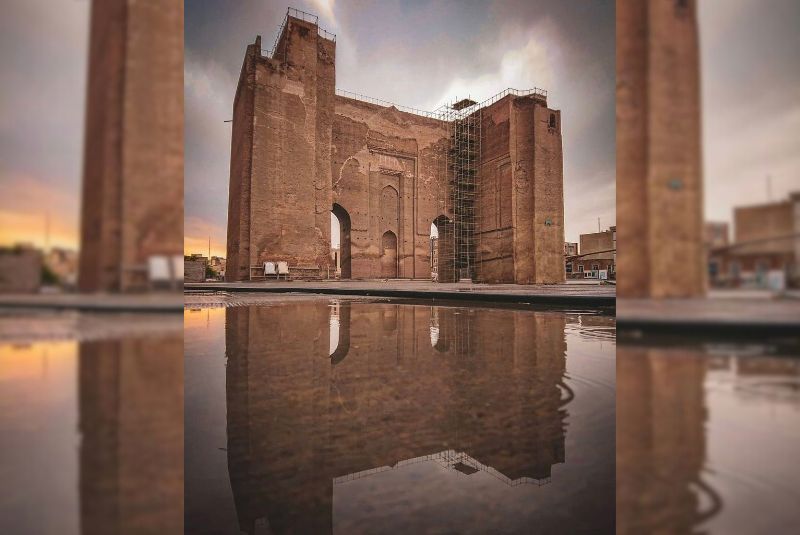
By Public Transport
You can easily reach Arg-e Alishah using public transportation. The closest bus stop is Saat Square, serviced by the Shariati-Abrasaan BRT line, from where you can take a short walk to the monument. Additionally, Shahid Mohaqeqi Metro Station is the nearest subway stop.
By Private Vehicle
If you are driving, bear in mind that the city center can be crowded, and parking spots near Arg-e Alishah are limited. You might need to park your vehicle in the surrounding streets, so plan accordingly for the busy traffic and limited space.
Tourist Attractions Near Arg-e Alishah
After visiting Arg-e Alishah, you can explore several nearby tourist attractions that offer a blend of history, culture, and architectural beauty. Below is a brief overview of some key sites you should consider visiting.
Saat Tower (Clock Tower)

The Saat Tower, also known as Tabriz Municipality Palace, is one of the iconic buildings near Arg-e Alishah. Built between 1935 and 1941, the building stands on a 9,600 square-meter site and has a 30.4-meter-high clock tower.
This clock, operational for over 70 years, chimes every 15 minutes, reminding the citizens of Tabriz that time marches on. Originally used as the seat of Tabriz’s first municipality, the building's unique U-shape resembles an eagle in flight when viewed from above. The Saat Tower now houses a museum, including the renowned Carpet Hall, which contains rare rugs over 110 years old.
Iron Age Museum
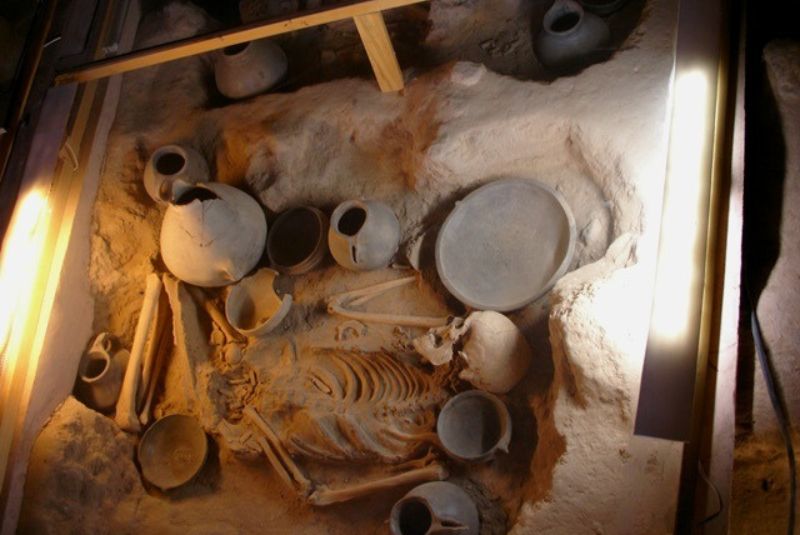
The Iron Age Museum is located near Arg-e Alishah and sits within an ancient burial site. Archaeologists have uncovered 38 graves here, with remains buried in a fetal position, symbolizing the womb.
Many graves contain pottery and personal items, including toys for children, jewelry for women, and weapons for men, indicating the burial customs of the time. This site provides insight into the spiritual beliefs of the Iron Age people, possibly followers of Mithraism. The museum offers well-preserved artifacts, including pottery and decorative items, and features limited entry, allowing only 15 visitors at a time.
Behnam House
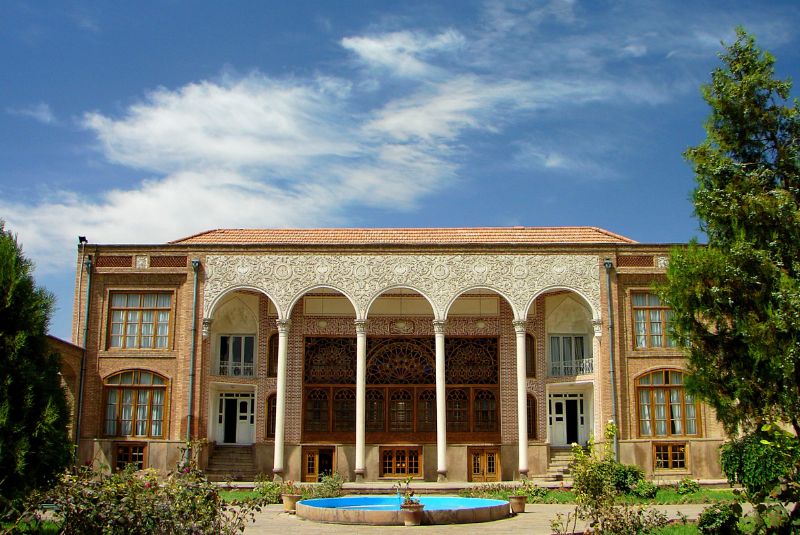
Behnam House, located in the Maqsoudieh neighborhood, is another historical gem near Arg-e Alishah. Constructed in the late Zand and early Qajar periods, the house was initially a private residence but now functions as part of the University of Islamic Art.
The building features beautiful fresco paintings, intricate stucco work, and an architecture typical of traditional Iranian homes, with an interior courtyard, a winter house, and a summer house. Visitors will also appreciate the stunning stained glass windows, which cast colorful light inside the house.
Tabriz Grand Bazaar
A short distance from Arg-e Alishah is the famous Tabriz Grand Bazaar, one of the world’s largest and oldest covered markets. Spanning an area of approximately one square kilometer, it is renowned for its brick architecture and maze-like alleys.
The bazaar is home to 35 saras (inns), 20 alleys, 25 arcades, and 5,500 shops selling everything from handwoven carpets and leather goods to spices and clothing. The bazaar’s historical significance is undeniable, having been a key trade hub along the Silk Road.
Constitutional House of Tabriz

The Constitutional House of Tabriz, built in 1868, played a significant role during the Constitutional Revolution of Iran. Located near the Jameh Mosque, the house was the gathering place for key revolutionaries such as Sattar Khan and Baqer Khan.
The architecture features stunning stained glass windows and ornamental woodwork. The museum inside displays relics from the revolution, including weapons, documents, and personal items of the revolutionaries.
Hotels Nearby Arg-e Alishah
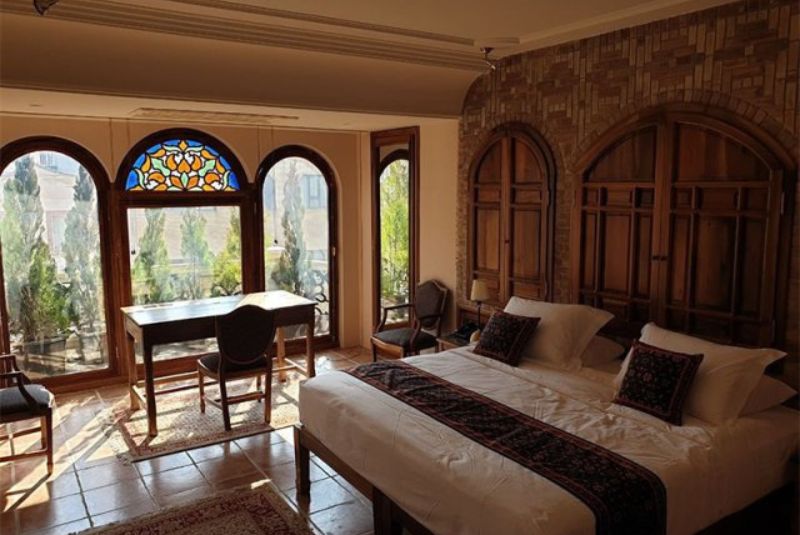
- Sahand Hotel Tabriz
- Arg Hotel Tabriz
- Ziba Hotel Tabriz
- Behbood Apartment Hotel Tabriz
- Nobar Hotel Tabriz
Restaurants Nearby Arg-e Alishah
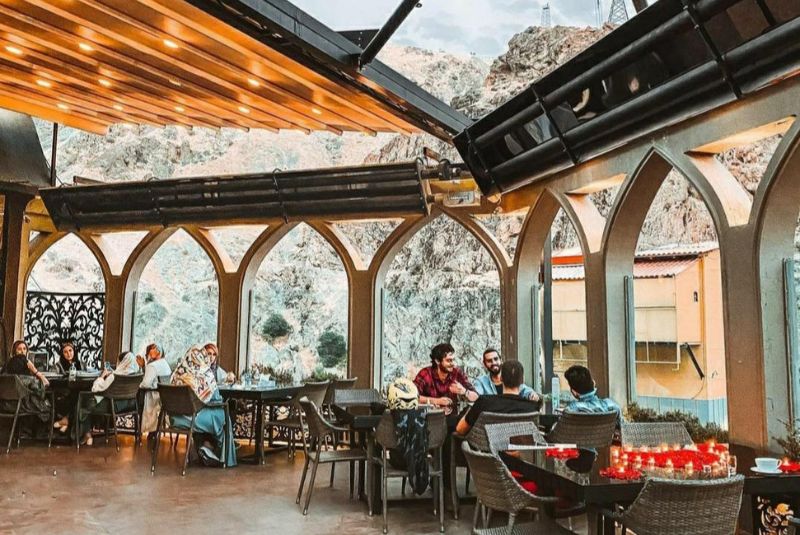
- Alishah Restaurant
- Khosrow Kebab Restaurant
- Osta Karim Stone Dizi
- Emarat Traditional Restaurant
- Lama Cafe and Restaurant
Bottom Line
Arg-e Alishah is a symbol of Tabriz’s rich history and resilience, standing tall for over 700 years. Originally built as a grand mosque and mausoleum during the Ilkhanate era, its ambitious design rivaled famous structures like Taq Kisra.
Despite architectural setbacks and later transformations into a military fortress during the Qajar era, the Arg has withstood wars and earthquakes. Its walls still bear the scars of battles, particularly from the Russo-Iranian Wars and the Constitutional Revolution. Today, while partially ruined, Arg-e Alishah remains a must-visit landmark, showcasing Iran’s architectural grandeur and historical significance.
Share your story!
Comment below and let us know about your Experience.
Your story inspires others!


Comment
Leave a Comment